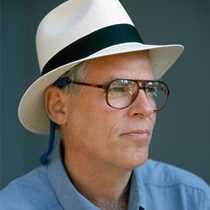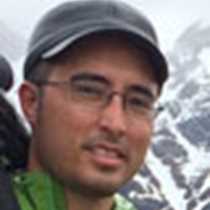The archipelago that makes up the Falklands includes 778 islands, of which only 499 are named. Total land area is 4700 square miles (12,173 sq. kilometers). Of these, most people live on just two islands, East Falkland, with 85% of the population, and West Falkland. We left the bright lights of Stanley yesterday afternoon under a beautiful sky with shafts of sunlight between layering clouds to visit two of the less visited and populated smaller islands.
This morning we reached Byron Sound and West Point Island at 7:15 a.m., at the most northwesterly point of West Falkland. Since the 18th c. sealers and whalers used and abused the property, leaving goats, pigs, sheep and long-horn cattle to run free, from which they harvested fresh meat each time they returned. The General Knox, a sailing vessel from Salem, Massachusetts, spent nearly two years anchored here in the harbor in 1820-21, receiving seal pelts from smaller ships. The sealers planted gardens on the island and harvested potatoes as well as local celery and scurvygrass.
Roddy Napier owns the island. He celebrated his 90th birthday yesterday in Stanley, where he and his wife Lily retired nine years ago after he spent his whole life on the island. His parents leased it until they bought it for £10,000 in 1959 and then promptly gave it to him. Roddy’s great uncle Arthur Felton was the first of his family to live on what was once called Albatross Island. In 1879 he began leasing it and established his sheep farm here. He immediately began restoring the island, replanting tussac grass where the wild cattle and fires set by the sealers had destroyed the grasslands. Within 30 years he’d planted almost the entire northern coast. Following Arthur’s prescient example, Roddy and Lily continued to care for and improve the wildlife and environment on the island. They helped set up the first bird-banding program in the Falklands and helped form what is now Falklands Conservation.
Lindblad Expeditions-National Geographic has a special connection to this island. Lars Eric-Lindblad first came here in 1968 on Navarino, a ship he chartered to bring guests to the Falklands. It was the beginning of environmental exploration and tourism here. He is considered the father of Falkland Islands tourism, and because the island and his friendship with Roddy and Lily meant so much to him his ashes lie under an attractive mass of Felton’s Flowers in the farmhouse garden. Roddy plans to return to West Point Island once more too as his final resting place.
With only the faintest breath of wind we landed here this morning. A knot of Magellanic penguins on the white sand beach ignored us. Further along the beach were kelp geese and some imported geese that are now feral. The kelp geese illustrate that some things really are black and white in this world. The female is dark brown, almost black, where the male is pure white.
Allan White and Jacqui Jennings met us at the farm’s pier. They’ve managed the island for the last 18 months. Allan is a 5th generation islander. John Short is one of his ancestors, an original settler in Stanley. Jacqui is 4th generation. They’ve been partners for the last 17 years. The farm buildings were tucked into the hills, surrounded by invasive gorse, which is brilliant yellow when in bloom. It was initially introduced to act as a windbreak, especially for newly-shorn sheep.
We took off heading west, climbing 350 feet, to walk or ride in Land Rovers the 1.4 miles in the valley between Black Bog Hill and Michael’s Mount to Devil’s Nose, an exciting viewing spot for 2,000 breeding pair of black-browed albatross, some of the 14,500 pairs of albatross on the island. We had unexcelled views of the birds and their nests as we looked towards Cliff Mountain, at 1211 feet both the highest point on the island and also the highest cliffs in the Falklands. Because tourists have been visiting the colony since 1968 when Lars Eric-Lindblad first arrived, the albatross didn’t seem to pay us any mind at all. They’d laid their eggs last September-October, and 70 days later the chicks popped their shells. They sat on tussac stumps, stripped of grasses, the top of the column hollowed out, rounded, curved, looking a bit as if it was a birdbath. But the nearly fledged chicks overflowed the edges, slightly too large at this age of their growth. We watched the adults soar off the cliffside and out across the ocean, catching updrafts, and appearing to soar effortlessly, and then return with food, sometimes crash landing among the chicks and nests.
There are also 400 pairs of rockhopper penguins at Devil’s Nose. They have bright red beaks and vivid lemon yellow tufts above their eyes that look like wild eyebrows. Altogether they have a bit of a madcap look to them. They were hopping up the cliffside, one hop at a time, but when jumping together in a waddle their hops seemed synchronized and even more impressive as they moved up the cliffside.
At one point Roddy was running 3000 sheep on the 3,100 acres island, and he needed to rotate the herds regularly not to overgraze. When tourism added to his revenue he was able to drop the numbers. They now farm 800 sheep and 23 head of cattle. This year they will ship 20 bales of wool to the UK, each bale weighing approximately 180 kilos. Wool has become a supplemental income, as tourism is now their main source. This year 45 ships will visit the island, up from 33 last year. Without tourism the farm couldn’t survive as sheep and cattle can’t alone pay the expenses and upkeep. The summer tourist season runs from mid-October through mid-March. Once it ends Allan will attend to the sheep and move them to winter grounds.
We pulled anchor and headed towards Greater Jason around 11:20 a.m. As we entered the Whoolly Gut, the passage between the island and the mainland of West Falkland, we saw many pelagic birds, including albatross, southern giant petrels, great shearwaters, sooty shearwaters, and penguins, along with such coastal birds as shags. As we rounded the island we could see Devil’s Nose from the sea. Offshore, a rock with a distinct profile is named Gibraltar Rock. We also were lucky to see dolphins, right and sei whales, the latter an elusive species few passengers had seen before.
We anchored off Grand Jason at 2:30 p.m. Only a few ships visit this pristine island, the largest of the Jason Islands, named after the vessel HMS Jason captained by John McBride, who brought settlers for Port Egmont in 1766. Sheep farming ended here in 1968. It is now a nature reserve run by Wildlife Conservation Society of New York. Without any rodents or cats on the island it has a large population of ground-nesting birds that include black-browed albatross (about 53,000 breeding pairs), rockhopper (about 5,000 pairs), gentoo (about 2,000 pairs) and Magellanic penguins, Cobb’s wren (the only endemic Falkland songbird), southern giant petrels (250 breeding pairs), tussacbirds and striated caracaras (the 250 breeding pairs comprise about half of the Falkland Islands’ population).
Even before landing, a tussacbird flew out to our ship and examined a Zodiac as we were boarding. Onshore they came up to us. The caracaras were also curious and sometimes surrounded us. These birds of prey of the family falconidae are known as Johnny Rooks in the Falklands. Primarily scavengers, they are intelligent and fearless. They found us interesting and followed us when we took off for a long hike or climbed through the high tussac grasses to view a black-browed albatross colony. Many of us took portraits of them as they watched us perched only a few feet away, sometimes balancing on top of a clump of tussac.
Others chose to explore the shoreline on Zodiac cruises on the exposed southwest coast and get a view of the bird colonies from the water. Maybe five times a year are there days like this. Normally on this side of the island the waves can average 15 feet high. Besides the birds, a pod of dolphins accompanied some of the Zodiacs all the way to the landing.
Bar manager Enrique set up an umbrella and table at the landing, serving cold drinks and cups of wine to returning hikers. Striated caracaras watched us with interest as we photographed a few Magellanic penguins lying on the rocks along the shore as well as an endemic subspecies of black-crowned night-heron. It patrolled a stretch of rocks to fish.
Returning to the ship at 6:00 p.m. we pulled anchor and began our 30-hour sail to the Beagle Channel and Ushuaia. Late afternoon sunlight raked the hillsides of the Jason Islands, bright against dark clouds on the eastern horizon while above and around us and to the west the clouds lit up as the sun set into the sea.
We quickly cleaned up in order to enjoy drinks and cocktails and watch footage that Caitlyn Webster, our undersea specialist, and Robert Alexander, our expedition diver, had shot in the morning on their dive at West Point Island in the clear and the relatively tropical and balmy waters—a toasty 50º F. compared to the chillier 26º F. they experienced in Antarctica at Brown Bluff. After another delicious dinner prepared by Chef Lothar and his culinary team, Mark Coger, our shipboard videographer, unveiled the world premiere of his video of our journey to Antarctica, South Georgia and the Falklands that featured interviews with staff and guests and Mark’s memorable photography. Afterwards Doug Gould, the shipboard naturalist and photo instructor, led a spirited and exciting auction, beginning with original paintings by crewmembers, followed by memorabilia from the ship. All the money goes to a crew fund.









